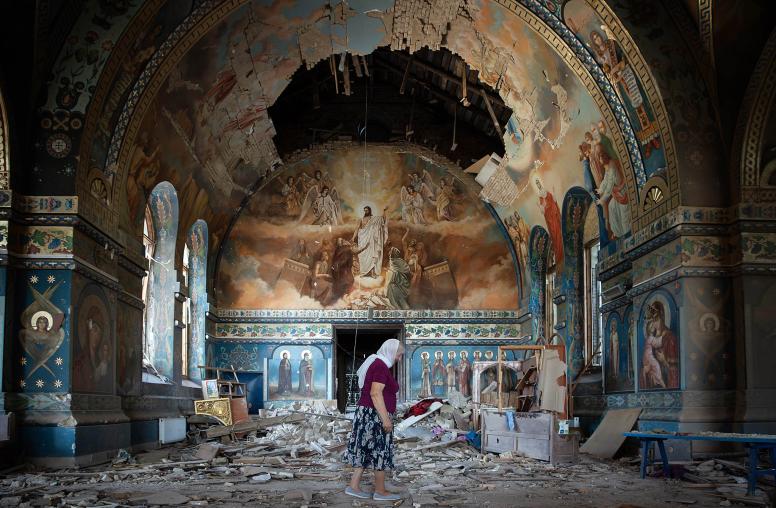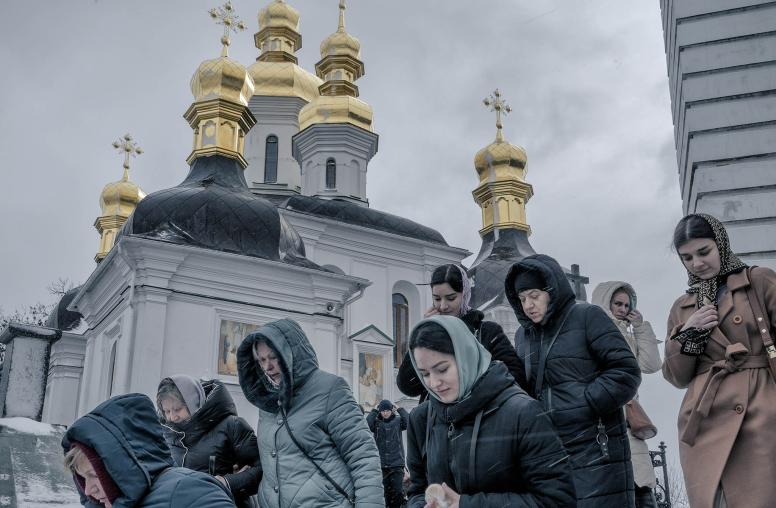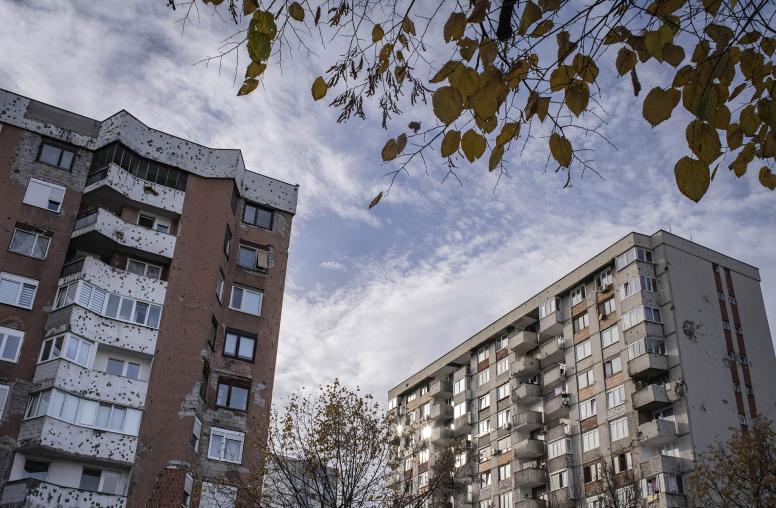In Religious Conflicts, Bolstering the Role of Military Chaplains
For U.S. forces, chaplains help interpret religious facets of conflict — a capacity we can strengthen.
In the 2020s, how urgently should the U.S. military prepare to address religious facets of armed conflicts? Violence from Beirut to the Red Sea this month threatens to spread the Israel-Hamas war regionwide. Violence fueled through religious identities and extremisms also afflicts Asia and Africa. Russia manipulates religion to justify its invasion of Ukraine. However, simultaneously, religious ideas can help resolve conflicts. The United States should seize a current opportunity to improve its ability to navigate the religious terrain of conflicts with enhanced training and roles for an often under-appreciated resource: military chaplains.

The U.S. military harvested arguably its most intensive lessons and insights on religion in modern conflicts over its two decades of intervention in Afghanistan and Iraq. Primary holders and interpreters of those lessons are the hundreds of military chaplains from those theaters — and the commanding officers whom they directly advised. With little training or preparation, U.S. chaplains became critical “religious ambassadors” between U.S. commanders and Afghan and Iraqi communities, channeling understanding that avoided violence, saved lives of local residents and U.S. soldiers — and advanced the interventions’ overall goals of building stability and reducing bloodshed. Yet we risk losing this expertise as that generation of chaplains retires.
The United States still has a window of opportunity to “lock in,” and build on, those hard-won lessons of the post-9/11 wars, but it should act quickly. The mechanisms for training chaplains should hasten to documenting the experiences and lessons learned from chaplains who served in Iraq and Afghanistan and should formalize training to enhance the capabilities of chaplains to do religious advisement work.
Iraq, Afghanistan — and Chaplains’ Roles
As insurgencies grew against the U.S.-backed governments in Afghanistan and Iraq a decade ago, the Army’s foundational field manual on countering insurgencies recognized religion’s “significant influence” in conflict zones. “Religious ideology can incite conflict, but religion can also be instrumental in stabilizing a culture by using universal religious concepts of justice, healing, and transformation,” it said. Religion’s influence, including the fact that “religious leaders have played an essential role in ending conflicts” means that, for U.S. forces, “The effect of a religion has to be understood within that religion and within that society,” the manual said. As U.S. units in Afghanistan and Iraq sought that understanding, the professionals they increasingly relied on, as people who intrinsically understand faith, were their chaplains.
Most U.S. media coverage, and the military’s own public presentation of chaplains, focuses on the work that the military calls “religious support” — the chaplain’s role as a spiritual counsellor to armed forces personnel. Indeed, that is the foremost mandate of chaplains’ roles across the services, and why many chaplains are drawn to serve. Unsurprisingly, the training for chaplains focuses on pastoral care and spiritual leadership. But the role that so dramatically expanded in Afghanistan and Iraq is what the armed forces call “religious advisement.” This means informing unit commanders “on the impact of religion on operations,” including “the impact of military operations on the religious and humanitarian dynamics in the operational area.” In that function, many chaplains learned “on the job” or out of their own, elective interests — but training around that role remains inconsistent.
U.S. commanders in Afghanistan and Iraq quickly learned that chaplains could be useful ambassadors to local religious leaders, helping commanders understand the concerns of communities among which U.S. forces were operating. In that role, and maintaining their critical noncombatant status, many chaplains found themselves working “outside the wire” — beyond the perimeters of U.S. bases — and often developing their religious advisement strategies on the fly.
A 2006 USIP study that interviewed 14 chaplains after their deployment noted how “military chaplains, as clergy and officers, occupy a unique space that blends a secular status and a religious one, making them well suited to serve as intermediaries between military and religious leaders in areas of conflict and post conflict stabilization.” It stressed that the “primary mediating focus of chaplains should be on establishing communications and building relationships with local religious leaders on the ground.” Such chaplains “must have a willingness and ability to interact with religious leaders of other faiths and must not be theologically and personally inclined to view those of other faiths as enemies.”
Retired Rear Admiral Chaplain Margaret Grun Kibben, now the chaplain for the U.S. House of Representatives, dealt with these challenges and opportunities when serving as command chaplain in Afghanistan. She emphasized the resource chaplains present to military commanders, noting that “Military chaplains help bring [religious dynamics] into the conversation….[they] create translation and build bridges” for their commanders, helping them to understand how religion fits into conflict dynamics and the possibilities of peace. But, based on her 35 years of service, she stressed the need to “continue to educate chaplains on this emerging role.”
'Strategic Religious Affairs'
The Pentagon has asserted the vital role of chaplains’ advisement at strategic levels, such as the theater-wide “joint commands” that oversaw operations in Afghanistan and Iraq. The Joint Chiefs of Staff issued a 2013 document (called Joint Publication 1-05) setting doctrine for such theater-wide operations. It laid out “chaplain's roles as the principal advisor to the joint force commander (JFC) on religious affairs and a key advisor on the impact of religion on military operations.”
In 2020, the Chairman of the Joint Chiefs of Staff issued instructions on Strategic Religious Affairs, underscoring that religious advisement “requires seasoned and trained [religious affairs] staff sections with the knowledge and background to understand complex religious issues and dynamics crossing various religious identities.” It added: “The identity of chaplains as religious figures makes them uniquely suited for engagement along religious lines.”
“It is increasingly essential that senior military leaders develop an awareness of, and appreciation for, the variety of global national-level challenges and issues related to religion,” the 2020 document stresses. For chaplains as advisors in this sphere, “the skills and knowledge required to master the impact and significance of religion across vast spans of nations, religious identities, ethnic groups, and migration trends … at the strategic level needs to be purposefully developed throughout the career of a chaplain.” However, efforts to expand and standardize religious literacy for chaplains have not yet produced consistent training or skills development.
Religion in Conflict and Peacebuilding
Civilian U.S. agencies are increasingly “religion literate,” informed in part by USIP’s efforts to understand religion in peace and conflict since the 1980s. The State Department’s Office of International Religious Freedom and ambassador-at-large have been working for 25 years. The newer effort to focus on the role of religion in global affairs has been pursued in stops and starts for a decade in U.S. diplomacy. And in September, the U.S. Agency for International Development issued a new “Strategic Religious Engagement Policy” for how USAID can partner with religious communities and faith-based organizations to expand opportunities to develop durable development solutions and deliver effective humanitarian assistance.
In better institutionalizing chaplaincy training to support the fuller religious advisement role that military leadership has declared vital, chaplain engagement in the Indo-Pacific should be the next area of focus, where majority religious traditions include non-Abrahamic faiths, with which many U.S. chaplains are less familiar, and where religious dimensions manifest in unique ways amidst the region’s vast pluralism and diversity.
The field of peacebuilding offers much to help chaplains advise U.S. forces confronting religious dimensions of conflict. A USIP guide, Religion in Conflict and Peacebuilding, lays out questions to consider in determining how religion fits into the landscape. USIP’s Global Campus courses can help chaplains develop particular skills in conflict assessment and religious engagement.
By analyzing the roles of religion in peace and conflict, military chaplains can help their commanders to consider the potential for negative or positive impacts of religion throughout their areas of operation and influence. With interstate conflict occurring or on the horizon, it is crucial to develop now a systematic approach to training chaplains to provide strategic religious advisement for their commanders and help them interpret the religious terrain.



